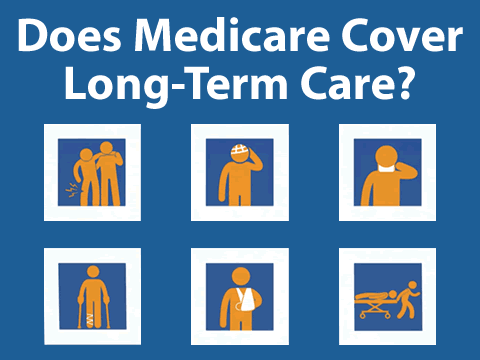Myth #1. A government program will take care of me
|
Government programs are difficult to qualify for and have very specific requirements for LTC services. Medicare, Medicaid and veterans'services -- may help pay for some LTC services in certain circumstances.
Yet each program has specific rules that define which services are covered, when benefits are paid, who can qualify and the dollar amounts individuals must pay on their own. Medicare doesn't cover most LTC expenses. Typically with Medicaid you have to spend down most of your savings to qualify for Medicaid assistance and there is a catch. |
Federal law requires states to recover the money Medicaid spent on their behalf from their estate after they pass away.(1)
Probate law dictates what states will include in estates, but typically this will include real and personal property, such as a home. This could force a person's spouse to sell their home, or Medicaid could put a lien on the house in the amount of the LTC expenditures.
Probate law dictates what states will include in estates, but typically this will include real and personal property, such as a home. This could force a person's spouse to sell their home, or Medicaid could put a lien on the house in the amount of the LTC expenditures.
Myth #2. I can save the money I need for long-term care services
Consider the facts:
Using capital to pay for care results in unnecessary taxes, market timing and liquidity issues. And just as important, every dollar used to pay for care is one dollar less toward keeping future commitments to the family, keeping commitments to charities and providing a legacy to those (you love).” (4)
- The average cost in 2010 for a one-year stay in a private nursing home room is $83,580.(2)
- The nationwide average cost for a private room in an assisted living facility is $3,450 per month.(3)
- Of all Americans age 65 and up today, 1-in-5 will require LTC services for five years or more.
- At today’s average cost, a couple with $500,000 in assets would deplete their savings in just a few short years paying for LTC services.
Using capital to pay for care results in unnecessary taxes, market timing and liquidity issues. And just as important, every dollar used to pay for care is one dollar less toward keeping future commitments to the family, keeping commitments to charities and providing a legacy to those (you love).” (4)
Myth #3. Only old people need long-term care services
|
Among adults age 65 and older, about 70 percent need some kind of help with the basic activities of daily living for weeks, months or even years as they age. (5)
It’s wise to begin looking into LTC protection well before services are needed for two primary reasons: cost and need. Potentially lower costs. By applying for insurance protection at a younger age, policy premiums — which are guaranteed never to increase — are lower. At the same time, getting approved for a policy or contract is easier at a younger age, when health risks are fewer. By contrast, waiting to make the purchase means paying potentially higher age-based premiums, needing more protection and risking being declined. |
Consider the need.
Even adults who aren’t elderly may need a little extra assistance from day to day. This can be due to an illness, injury, chronic condition or disability. Help also may be required due to aging-related declines in eyesight, hearing, strength, balance and/or mobility.
Myth #4. I don't need separate LTC protection because I have health insurance

LTC protection is not the same as health insurance, which is designed simply to cover the costs to cure individuals and return them to good health.
Health insurance is intended to help pay for medical care only, but LTC insurance benefits help support potentially costly LTC services, which can include bathing, eating, getting dressed and moving around.
LTC services generally are required by those who are dealing with chronic illnesses, accidents or advanced aging and are progressive, with the level of needed care growing over time
Health insurance is intended to help pay for medical care only, but LTC insurance benefits help support potentially costly LTC services, which can include bathing, eating, getting dressed and moving around.
LTC services generally are required by those who are dealing with chronic illnesses, accidents or advanced aging and are progressive, with the level of needed care growing over time
Myth #5. I can't afford long-term care insurance
Fact: The cost for LTC protection can fit nearly anyone’s budget and financial goals. LTC protection may seem expensive, but not having it can be much costlier to individuals and families. LTC costs can quickly deplete a person’s hard-earned life savings.
LTC products can offer a broad selection of funding options. Mutual funds, cash or Section 1035 exchanges from existing life insurance or an annuity can be used to fund LTC protection with a single lump-sum premium. Another option is to pay policy premiums — which are guaranteed never to increase — over a period of 10 to 20 years.
LTC products can offer a broad selection of funding options. Mutual funds, cash or Section 1035 exchanges from existing life insurance or an annuity can be used to fund LTC protection with a single lump-sum premium. Another option is to pay policy premiums — which are guaranteed never to increase — over a period of 10 to 20 years.
Myth #6. We don't need long-term care protection because we have each other.

The reality is that LTC situations impact not only the individual who needs care, but also the entire family — across generations.
Family members who provide care without being paid are the most common source of LTC help in the U.S. today. Typically, family members step into caregiving roles, often making great personal sacrifices to take on the extra responsibilities.
But they might not be able to meet every need and be available every hour of the day.
Anyone who is considering caring for or receiving care from a family member should thoughtfully consider these questions:
LTC situations can take a heavy emotional and financial toll on even the closest, strongest families. With the extra help of LTC protection, a family member can enjoy independence longer without sacrificing comfort or having to feel like a burden to others.
Family members who provide care without being paid are the most common source of LTC help in the U.S. today. Typically, family members step into caregiving roles, often making great personal sacrifices to take on the extra responsibilities.
But they might not be able to meet every need and be available every hour of the day.
Anyone who is considering caring for or receiving care from a family member should thoughtfully consider these questions:
- Would you realistically want to care for the family member?
- Would you trust a family member to provide care for you?
- Are you physically and mentally capable of caring for each other?
- Is caregiving what you really want for each other for your future?
LTC situations can take a heavy emotional and financial toll on even the closest, strongest families. With the extra help of LTC protection, a family member can enjoy independence longer without sacrificing comfort or having to feel like a burden to others.
Solution:
Spending down your savings to pay for potential long term care needs isn't necessary.
With a one time only or an annual premium you can:
With a one time only or an annual premium you can:
- Increase your asset value (This value remains with you or your beneficiary if you never need LTC services)
- Protect your savings from expensive long term care, if needed.
- Receive income tax protection spending on LTC services or also leaving behind your increased benefit value to your family.
and it is guaranteed that
- Your premiums will never increase
- Your cash value earns tax deferred interest never to go below a specified set interest rate.
To setup a free consultation, contact:
Ricky Moore
(1) “Estate Recovery and Liens.” Medicaid.gov. www.medicaid.gov/medicaid-chip-programinformation/by-topics/eligibility/estate-recovery.html.
(2) “Costs of Care.” LongTermCare.gov. http://longtermcare.gov/costs-how-to-pay/costs-of-care.
(3) According to the Genworth 2014 Cost of Care Survey
(4) Gordon, Harley. The Conversation: Helping Someone You Love Plan for an Extended Care Event. Acanthus Publishing. 2016
(5) “How Much Care Will You Need?” http://longtermcare.gov/the-basics/how-much-carewill-you-need/



